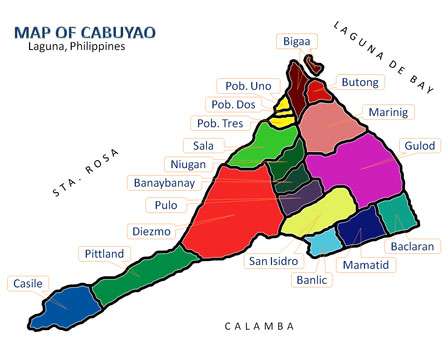Poblacion II, Cabuyao
Barangay II Poblacion or Barangay Poblacion II (or simply Barangay Dos) (PSGC: 043404002) is one of the eighteen (18) urbanized[1] barangays comprising the City of Cabuyao in the province of Laguna, Philippines. It is one of the three (3) Poblacion barangays of the city. According to the 2010 Census,[2] it has a population of 1,840 inhabitants (from 1,947 in Census 2007[3]), ranking 17th when it comes to population. Barangay II is part of the City Proper or the Business District of Cabuyao, it is the center for commercial and business establishments, Supermarkets, Restaurants and Schools that can be found in Cabuyao.
Barangay II Poblacion Barangay Poblacion Dos City of Cabuyao | |
|---|---|
| Nickname(s): Barangay Dos, Poblacion Dos | |
| Country | |
| Region | Calabarzon (Region IV-A) |
| Province | Laguna |
| City | Cabuyao |
| Incorporated (settlement) | 1571 |
| Government | |
| • Type | Sangguniang Barangay, with Chairman as its head supported by seven (7) Barangay Councilors |
| • Barangay Chairman | Michael L. Dalmacio |
| Area | |
| • Poblacion | 0.23333 km2 (0.09009 sq mi) |
| Population (May 2010) | |
| • Poblacion | 1,844 |
| • Density | 7,900/km2 (20,000/sq mi) |
| • Urban | 1,840 |
| Time zone | UTC+8 (PST) |
| • Summer (DST) | Manila |
| Zip Code | 4025 |
| Area code(s) | 049 |
| Languages | Tagalog and English |
Barangay II is the busiest district of Cabuyao, the Cabuyao Public Market or the Pamilihang Panlungsod ng Cabuyao and the Cabuyao Retail Plaza (Cabuyao Town Center) is located in Barangay II. It is also the home of the Cabuyao Central School.
Geography
Climate
Types of Seasons
The rainfall regime of Barangay Dos is characterized by the two (2) pronounced seasons, the wet and dry seasons. The wet season which is from June to November and the relatively dry season that lasts from December to May. The average rainfall is about 2,000 mm of rain falling in an average year, there are about 150 days which are rainy days.[5]
Temperature
The seasonal variations of the Temperature field is uneventful. The coldest months start from November up to January and the warmest month on the record is the month of May. On the average, a 12 °C temperature difference exists between the warmest and coolest months. The mean annual temperature is a warm 27.5 °C.[5]
Humidity
The annual relative Humidity is 70%. The most humid months are June, July, August and September with the normal relative humidity registered at 84%, while April and May are the driest at 70%.[5]
Demography
According to 2010 Census,[2] it has a population of 1,840 inhabitants, from 1,947 in Census 2007.[3]
| No. | Barangay | Rank | Population (2007) | Population (2010) | Population Density (2010) | Annual Growth Rate (Average) |
|---|---|---|---|---|---|---|
| 1 | Baclaran | 9th | 12,683 | 12,192 | 6,985/km2 | |
| 2 | Banay-Banay | 4th | 17,419 | 21,934 | 7.073/km2 | |
| 3 | Banlic | 7th | 9,707 | 12,675 | 5,511/km2 | |
| 4 | Bigaa | 10th | 8,649 | 10,051 | 4,807/km2 | |
| 5 | Butong | 8th | 12,274 | 12,360 | 7,630/km2 | |
| 6 | Casile | 16th | 1,555 | 2,128 | 669/km2 | |
| 7 | Diezmo | 15th | 2,689 | 2,681 | 1,686/km2 | |
| 8 | Gulod | 11th | 10,127 | 9,417 | 2,304/km2 | |
| 9 | Mamatid | 1st | 37,166 | 50,213 | 19,313/km2 | |
| 10 | Marinig | 2nd | 25,619 | 37,169 | 9,494/km2 | |
| 11 | Niugan | 3rd | 21,993 | 26,807 | 7,615/km2 | |
| 12 | Pittland | 18th | 1,627 | 1,740 | 598/km2 | |
| 13 | Pulo | 6th | 13,193 | 15,124 | 5,041/km2 | |
| 14 | Sala | 12th | 7,491 | 8,275 | 5,353/km2 | |
| 15 | San Isidro | 5th | 15,495 | 18,145 | 5,767/km2 | |
| 16 | Barangay I Poblacion | 14th | 2,589 | 2,839 | 12,334/km2 | |
| 17 | Barangay II Poblacion | 17th | 1,947 | 1,840 | 7,886/km2 | |
| 18 | Barangay III Poblacion | 13th | 3,153 | 2,846 | 12,034/km2 | |
| TOTAL | 6th | 205,376 | 248,436 | 5,700/km2 |
Barangay Officials (2018-2020)
Barangay Chairman: Michael L. Dalmacio
Sangguniang Barangay Members:
- Melvin Calandria
- Claudine Maraña
- Morisse Delmo
- Amelita Centeno
- Lolita Pañares
- Abe Nazareno
- Erwin Alcones
SK Chairperson
- Rhemie Baroro
See also
- Cabuyao, Laguna
- Laguna, Philippines
- Poblacion
References
- Philippine Standard Geographic Code
- "Final Results - 2010 Census of Population". census.gov.ph. Archived from the original on 2012-07-07. Retrieved 2012-06-16.
- 2007 Census table for Laguna Archived 2011-06-07 at the Wayback Machine - National Statistics Office
- Cabuyao, Laguna/Barangay Location Archived 2012-01-28 at the Wayback Machine
- Cabuyao, Laguna/Physical Characteristics Archived 2010-10-29 at the Wayback Machine
